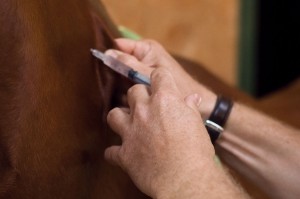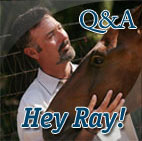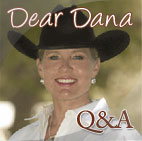Checklist for Fall
Fall is here, and it is a great time to visit on items to take care of on our horses. It is a great time as show season is slowing down and the temperatures are more pleasant. So, let’s go over some items to consider for the fall.
 First is vaccines—If you need Flu/Rhino boosters due to your situation, now is the most common time to get them.
First is vaccines—If you need Flu/Rhino boosters due to your situation, now is the most common time to get them.
Fecal Egg Count—Twice a year, you should be testing your horse’s parasite load and deworming appropriately
Dentistry—This is a great time of year to have those points removed and any abnormalities resolved. Going into winter, you want your horse getting the most from its feed.
Lights—If you are planning on breeding in the late winter or early spring, you want your horses ready to go and cycling properly. Day length plays a role in both the mare’s and stallion’s reproductive cycle.
Elective surgeries—Things like castrations can be done most any time, but if possible, I like to do them this time of year. The weather is cooler and there are less flies. The horses usually heal a little more quickly and with less complications
Blanketing—If you do blanket, it is time to make sure they are in good order and depending upon wehre you live, time to start using them!
As the year is winding down and we are getting into holiday season, do not forget some of the extra needs your horse may need this time of year.
It is also important to make sure your horse’s housing in is good order. With wind, rain, and cold on the way, it is good to make sure any repairs have been taken care of and for those of us in areas that freeze, that our water heaters are functioning properly.
Also, do not neglect the hay storage areas. Water getting on hay is destructive. Pests are looking for somewhere to set up shop. You need to protect your hay from water, rats, mice and rabbits.
Hopefully this list stokes some ideas on things to get taken care of. Happy Thanksgiving!
Home stretch of the show season
 For most people, we are rounding the last corner and headed to the finish line for show season. Many equine athletes have been going hard all spring and summer. Keeping our horses sound and performing at their peaks takes some extra efforts on our part. I will try to touch on some key points that can be beneficial to keeping our horses happy and performing.
For most people, we are rounding the last corner and headed to the finish line for show season. Many equine athletes have been going hard all spring and summer. Keeping our horses sound and performing at their peaks takes some extra efforts on our part. I will try to touch on some key points that can be beneficial to keeping our horses happy and performing.
First off is nutrition. When traveling, I would recommend keeping your horses diet as close to normal as possible. Take at least the supplements and concentrate feeds that you feed at home. If you can, take the same hay also. Changing diets on the road can lead to colic and lost competition days. While we are on nutrition, I feel it is really important to keep a performance horse on a good quality joint supplement and vitamin mineral supplement. You want their joints as comfortable as possible. You also want their metabolism working at its peak to give them the energy they need.
Beat the heat
 Well, August is here and so is the heat. July showed us some very hot temperatures, but we still have the late summer and early fall heat waves to deal with. We have discussed most of this before, so here are some reminders.
Well, August is here and so is the heat. July showed us some very hot temperatures, but we still have the late summer and early fall heat waves to deal with. We have discussed most of this before, so here are some reminders.
1. The cornerstone to surviving this heat for our horses is water. Access to plenty of clean and cool water is essential.
Identifying your horse
 We all love our horses. We invest time and money into their care and upkeep. I think it is natural for us to want to protect the emotional and financial investment we have in our horses. This month I am going to discuss the various forms of identifying our horses.
We all love our horses. We invest time and money into their care and upkeep. I think it is natural for us to want to protect the emotional and financial investment we have in our horses. This month I am going to discuss the various forms of identifying our horses.
Registration Paperwork
Each breed registry has its own method for identifying the animal for which they produce papers for. Pictures, written descriptions, and drawings are found on these different documents. They usually also include the parentage of the registered horse.
Fly control
 If you have horses, you likely have to deal with fly problems at least part of year. Flies are necessary to the environment. They help to breakdown waste products and can even be beneficial in cleaning up infected wounds. Flies also can transmit diseases and spread infection to wounds. They also can cause stress to our animals just from their annoyance. This month, let us discuss some methods for controlling flies.
If you have horses, you likely have to deal with fly problems at least part of year. Flies are necessary to the environment. They help to breakdown waste products and can even be beneficial in cleaning up infected wounds. Flies also can transmit diseases and spread infection to wounds. They also can cause stress to our animals just from their annoyance. This month, let us discuss some methods for controlling flies.
Springtime checklist
 Springtime is here. The weather should be getting better, the days are getting longer. So hopefully this gives us more time for playing with our horses. This month, I have a checklist for spring.
Springtime is here. The weather should be getting better, the days are getting longer. So hopefully this gives us more time for playing with our horses. This month, I have a checklist for spring.
1)Coggin’s test. With showing and traveling coming up, it is a good time to renew your annual Coggin’s test. It is needed for some shows, travel across state lines and even at some boarding facilities.
2)Vaccines. This is a good time to get those spring vaccines done. You especially want to booster those diseases, like West Nile disease, that are spread by mosquitoes, as the mosquito population will be out soon. Remember your core vaccines: Eastern and Western Encephalitis, West Nile, tetanus, and rabies.
Joint Supplements
 Joint supplements are always a hot topic. Most people are concerned about the athletic performance of their horses and anything they can do to keep them going at their maximum performance level. This month I am going to discuss the most common ingredients, how they are given, and what we think they do.
Joint supplements are always a hot topic. Most people are concerned about the athletic performance of their horses and anything they can do to keep them going at their maximum performance level. This month I am going to discuss the most common ingredients, how they are given, and what we think they do.
Hyaluronic Acid (HA). HA is found naturally throughout the body. It is used to improve the lubricity (viscosity) of the joint fluid and to reduce inflammation. Cartilage in the joint is like a sponge. The joint fluid fills it up and pressure from weight on the joint expels the fluid. If the fluid is more viscous or thicker, it is harder to expel from the cartilage, and therefore absorbs more concussion. Inflammation makes the joint fluid more watery or less viscous. HA aims to combat that. It is commonly given intravenously (IV), intraarticularly (IA, or in the joint), and orally.
Horse care and the internet
 Anyone who knows me knows I use and enjoy the internet. It has improved many things in our society. In veterinary medicine, it is used for telemedicine, sharing radiographs, and quick, easy access to continuing education and research work, just to name a few things. With that being said, there are situations that come up where horse owners turn to the internet for their equine needs, and I wanted to give some warnings on a couple of common situations.
Anyone who knows me knows I use and enjoy the internet. It has improved many things in our society. In veterinary medicine, it is used for telemedicine, sharing radiographs, and quick, easy access to continuing education and research work, just to name a few things. With that being said, there are situations that come up where horse owners turn to the internet for their equine needs, and I wanted to give some warnings on a couple of common situations.
Social media. It is a part of a tremendous number of people’s lives. People often turn to social media to ask questions from their online friends from all over the world. I even try to help out where I can with people asking questions in different groups online. This arena is a difficult one to navigate as a professional trying to help horse owners. We as professionals are required to have a valid veterinary client-patient relationship to offer a diagnosis or treatment recommendation. If we have not examined the animal, we do not have this. Some people may get frustrated with ambiguity or even lack of answering certain things because we can’t. We have not seen the horse. We should not be expected to put our necks out there to open ourselves to the liability if something does go wrong.
Let’s flush out facts about ‘choke’
 Choke in the horse is a common problem we see in equine practice. We were asked about choke and how to prevent it, so let’s discuss what it is, what you can do, what we as veterinarians can do and some tips on prevention and management.
Choke in the horse is a common problem we see in equine practice. We were asked about choke and how to prevent it, so let’s discuss what it is, what you can do, what we as veterinarians can do and some tips on prevention and management.
Before we go any further, let’s define what choke is in horses. It is when the esophagus gets obstructed, usually with feed material. The esophagus is the tube that carries masticated (“chewed up”) food and saliva from the mouth to the stomach. When the esophagus is blocked, saliva and food material back up in the back of the oral cavity in the area called the pharynx. When this occurs, the common clinical signs are copious amounts of fluid mixed with feed draining from the nose, a desire to eat but not actually eating, cough, extending of the neck and lowering the head.
The pre-purchase exam
 The pre-purchase exam is done when looking at a horse to buy, and you are looking for a professional, objective opinion on a horse prior to purchasing it. Each practitioner is most likely going to use their own method to do it and will include or exclude certain things based on their training and experience. The way I do my exams, they are broken down into two distinct different sections.
The pre-purchase exam is done when looking at a horse to buy, and you are looking for a professional, objective opinion on a horse prior to purchasing it. Each practitioner is most likely going to use their own method to do it and will include or exclude certain things based on their training and experience. The way I do my exams, they are broken down into two distinct different sections.
The Physical
The first part of the exam, I start with an in-depth physical exam. I start at the nose and work my way back. I look in the mouth to check the gums. Next, I run fingers over the teeth to check for current floating status. I move next to the eyes. First, I check the menace response which involves moving toward the eye to see if the horse blinks. After that, I use my ophthalmoscope to do an exam of the back of the eye, called the fundus. I examine the optic nerve and the retina. I move to the ears, looking for parasites or masses.



 Read Columns
Read Columns

